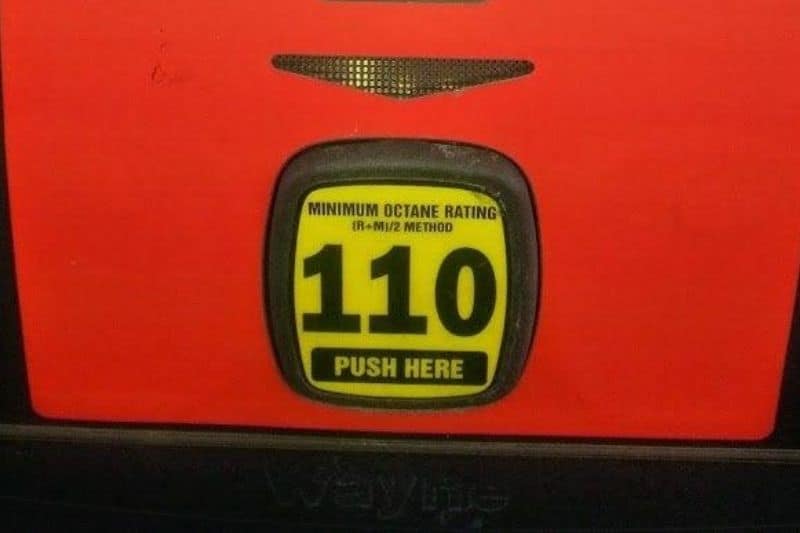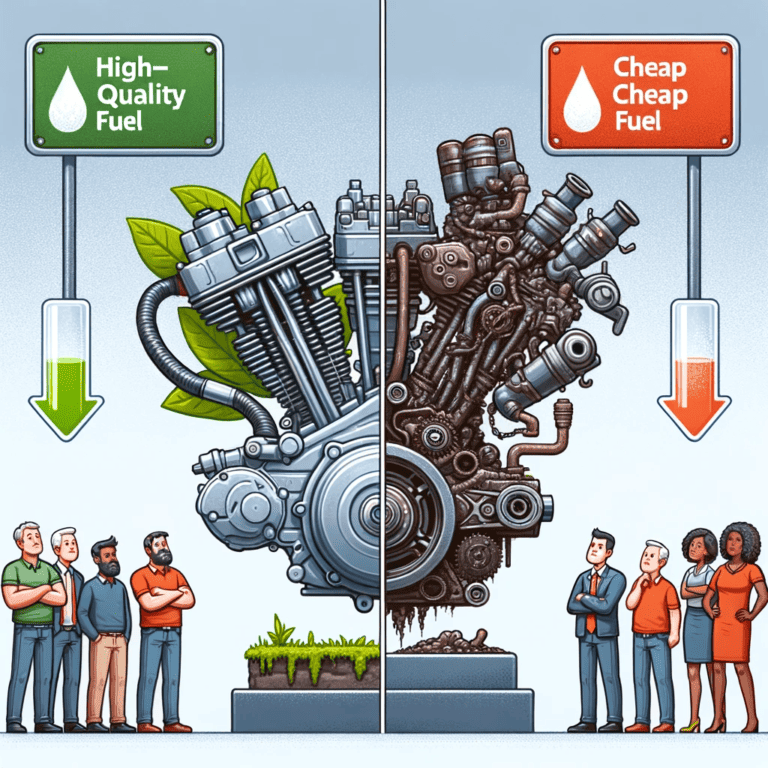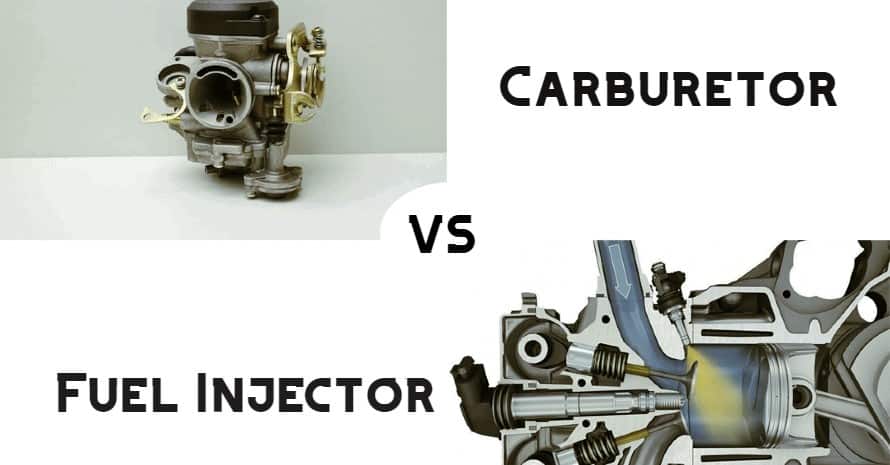Octane is probably one of the most misunderstood things when it comes to motorcycles. Many motorcycle owners still prefer to buy as high of an octane fuel as they can possibly lay their hands on. Some may even try to get fuel with a 110-octane rating. So is this a good idea?
Will 110 Octane Hurt My Motorcycle? Fuel with a 110-octane rating will not hurt your motorcycle as long as it is lead-free. The majority of motorcycles run on fuel with an octane rating between 87 to 94, which means they can handle 110 octane fuel. However, 110 octane fuel may negatively affect the motorcycle’s performance.
Table of Contents
To learn more about octane and what can 110 octane do to your motorcycle’s engine continue reading below, I share with you more interesting information.

Does 110-octane fuel make a difference?
A lot of motorcycle owners may still believe that the octane rating makes their motorcycles go fast. However, in reality, the octane rating is not what makes their motorcycles so fast. This is a common myth that is as old as the first motorcycle ever built.
In simple terms, the octane rating measures how much pressure the fuel can withstand before self-combusting. If subjected to enough pressure, fuel will explode on its own—in other words, there will be no need for a spark to ignite it.
This is important for a few reasons.
Motorcycle engines (and engines in general) generate different amounts of pressure as the piston goes up and compresses the fuel. When the fuel is compressed by the piston and the piston has reached its top dead centre (TDC), the spark plug generates a spark that ignites the fuel.
You want the spark plug to ignite the fuel—and not the fuel to self-ignite on its own. If the fuel self-ignites, this can cause engine knocking, which will wear out and damage the engine’s internal parts.
While the piston is at its TDC, the fuel will be subjected to a lot of pressure. If the fuel is of the wrong octane rating, it may self-combust before the spark plug fires.
A higher octane rating fuel can withstand more pressure than a lower octane fuel. This means that if your engine generates a lot of pressure (meaning it takes high-octane fuel) and you feed it with low-octane fuel, the fuel will self-combust—this is also known as pre-ignition.
The best way to find what octane-rating fuel you should use is to check your motorcycle’s user manual. There you will see what kind of gas your motorcycle uses. If it says that you should use gas with an octane rating of 90, then you should not go below 90.
As you can see, now, going with a higher octane rating than what your motorcycle’s engine has been set up to use will not do anything for you in terms of speed and power.
The first difference that you will notice by using a 110-octane fuel is that it smells differently—smells really good, but different than regular gas.
Next, there is a chance that using 110 octane fuel on a stock motorcycle may reduce its power.
That being said, there is a chance that such fuel may have been better filtered and processed with more added detergents, making it cleaner than regular fuel.
This brings us nicely to the next question if you cannot go below, can you go above?
Is 110-octane fuel safe for motorcycles?
Typically, motorcycles produced today will take fuel with an octane rating of anywhere between 87 to 94. Going with a higher octane rating than what your motorcycle should use—found in your manual—usually warrants no benefits.
For a while, it was considered that a higher octane fuel should, in theory, burn at higher temperatures.
However, that is considered another common myth.
There will be a difference in the burning temperatures between low-octane and high-octane fuel, however, that difference is not that significant to normally cause any problems.
So, yes, 110 octane fuel can be used in motorcycles. Fuel with an octane rating of 110 can be considered racing fuel, and it is very hard to come by. Using 110-octane fuel, in general, will not provide any benefits in terms of speed or performance.
That being said, it is common for 110 octane fuel to be led, which may be a problem in certain cases.
The lead in the fuel can leave lead salts deposited inside your engine and fuel system, which may be problematic. These deposits will lubricate the valves and valve seats; however, they can also damage and clog the catalytic converter, damage the fuel injectors and sensors, foul the spark plugs, and corrode the exhaust pipes.
And let’s not forget that leaded fuel is considered illegal in many places. However, there are still countries where selling leaded fuel is perfectly legal.
Sometimes 110 octane fuel can also be highly oxygenated, which can be really detrimental to your motorcycle’s engine.
The most commonly used oxygenating agent is ethanol, and nowadays, gasoline sold at gas stations usually has about 10% ethanol in it.
Ethanol can be very detrimental to motorcycle engines. Usually, the majority of motorcycles built today can handle up to 10% ethanol.
However, going above that is not recommended by the majority of manufacturers. Some may even void the motorcycle’s warranty if fuel with high ethanol content has been used.
Should you use 110-octane fuel on your motorcycle?
Unless you already have some 110-octane fuel lying around in your garage, there really is no need to use it. It is more expensive while not offering anything in return that will make up for the higher price tag.
What is more is, that since it is considered more of a racing fuel, it is no surprise that usually, the fuel found at the majority of gas stations is with lower octane.
Typically on most gas stations, you will find a few different types of gasoline.
- Regular: This is gasoline with the lowest octane rating, generally speaking, about 87.
- Plus: This is mid-range gasoline that typically has an octane rating between 88 and 90.
- Premium: This is gasoline with the highest octane rating, typically between 91 and 94.
Using the fuel with an octane rating that is not suitable for the motorcycle’s engine may hurt your motorcycle in the long run.
However, motorcycles are all very different and may take different types of fuel. This is why you should always stick to the manufacturer’s recommendations.
If the manufacturer of your motorcycle recommends using fuel with an octane rating of 90, then you should never go below that. Doing so, you are risking damaging your engine. Going above 90 will not be of any benefit to you either. Over time it can lead to more than normal carbon deposits, but otherwise, it will not provide a speed boost or any advantages.
Even if you have access to 110-octane fuel, it will not necessarily hurt your motorcycle in any way. However, it will be more expensive, and you will be paying more for the same performance and results that you can get with a cheaper, lower-octane fuel.
Overall there is no reason to go with a higher octane fuel than what has been specified in your manual. You will just be paying more for the same results.
When you can benefit from using 110-octane fuel
If there really was no purpose to higher octane fuels like this, then it would not have been made in the first place. So, yes, there is a good reason why 110 octane fuel has been made.
If you use 110-octane fuel in a stock motorcycle engine, you will not see any benefits of using it.
For the 110-octane fuel to actually make a difference, your motorcycle’s engine should be properly modified in order to generate higher pressure. Only then will you be able to see any benefits of using such fuel?
A properly modified engine with increased compression running on a suitable high-octane fuel will have more power.
Lastly, if you are really interested in improving performance and economy, this, perhaps, can be achieved by going with ethanol-free fuel.
Ethanol is used to increase the octane rating of gasoline. However, it generates less energy than gas when it burns. For example, according to the data, the mpg of fuel with 10% ethanol (E10) will be, on average, 3% to 4% lower than pure gasoline.
Overall unless you are prepared to do some extensive modifications and change the engine’s programming to allow it to actually utilize the higher octane fuel, there is no reason to use it.
FAQ’s
- Will 110 Octane Hurt My Motorcycle?
- This question addresses concerns about using fuel with a high octane rating, specifically 110 octane, and its potential impact on motorcycles. It emphasizes that as long as the fuel is lead-free, it won’t hurt the motorcycle, but it might affect performance.
- Does 110-octane fuel make a difference?
- This question tackles the common misconception that higher octane fuels result in increased motorcycle speed and performance. It clarifies the relationship between octane rating, pressure, and ignition, while explaining that using 110-octane fuel on a stock motorcycle might not bring the expected benefits.
- Should you use 110-octane fuel on your motorcycle?
- This question provides practical advice on using 110-octane fuel in motorcycles. It explains that following the manufacturer’s recommendations for the appropriate octane rating is crucial, and using higher octane fuel without necessary engine modifications won’t provide significant advantages.

Meet Simon, the 46-year-old aficionado behind YourMotoBro. With a lifelong passion ignited by motocross dreams and a Canadian Tire bicycle, Simon’s journey has been nothing short of extraordinary. From coaching underwater hockey to mastering muddy terrains, he’s an authority in thrill and adventure. Certified as an Off-Road Vehicle Excursion Guide and trained in Wilderness First Aid, Simon’s love for bikes is as diverse as his collection—from a robust BMW GSA R1200 to the memories of a Harley Davidson Night Train. By day a respected telephony consultant, by night a motorcycle maestro, Simon’s tales are a blend of expertise, resilience, and undying passion. ?️✨

